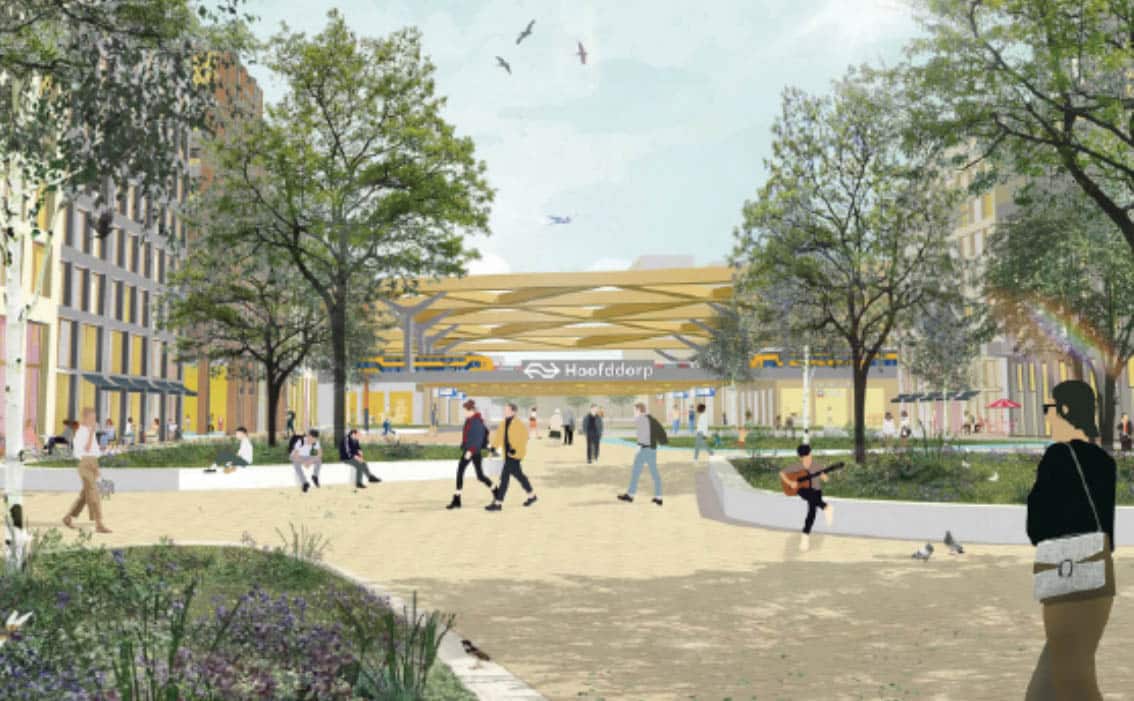Closer - The City of Proximity
An afternoon about proximity and the urbanisation of station areas, organised in collaboration with De Zwarte Hond, bringing together examples from Paris and the Netherlands. Thursday 17 October, 16:30 – 18:30.

The urbanisation of station areas and public transportation hubs is a major focus in urban planning today, driven by the goals of proximity and sustainable mobility. These areas, often located in already developed districts, are ideal for mixed-use development and frequently require improvements to their environmental quality.
Research shows that as cities become denser, with more housing, jobs, and amenities, people's mobility patterns shift. Walking and cycling become more common, and car use declines. This reduction in car dependency frees up space currently occupied by moving and parked cars. This newfound space can be repurposed for more "green" and "blue" areas, which can help cities and towns better handle extreme weather events like droughts, heatwaves, and heavy rainfall, while also boosting biodiversity. Additionally, people tend to appreciate living environments that feature more greenery and less asphalt and metal, which encourage physical activities like walking and cycling. Such environments are not only beneficial for physical health but also for mental well-being.
Densification also brings new investments into existing neighborhoods. This co-investment can support the transitions these areas are already undergoing, such as funding the construction of heat networks, creating climate-adaptive green spaces, improving the housing market, and diversifying mobility options.
After a welcome by Mike Emmerik from Independent School for the City, urbanist and partner Daan Zandbelt motivated in his presentation why station areas are ideal locations for urbanization. Patricia Pelloux of Apur - Atelier parisien d'urbanisme, the Paris Urbanism Agency that analyses and imagines the urban and societal evolution of the Grand Paris Metropolis, then highlighted which urban developments are taking place in Paris. Lastly, there was a presentation on Dutch station areas that are currently being renovated or will be in the future.
About Out there #5 - ‘The future is proximity
In march 2024 De Zwarte Hond published a bookazine titled "The Future is Near – Why Station Areas Are the Ideal Locations for Urbanisation." The publication delves into why and how proximity can be achieved in station quarters. Building on the insights from this bookazine, this event will further explore the potential for densifying station areas, drawing on examples from the Netherlands and Paris, where the concepts of the 15-minute city and transport-oriented development are key principles guiding the urbanisation of the Greater Paris region.
About Patricia Pelloux
Patricia Pelloux is deputy director of Atelier Parisien d'urbanisme (Apur). After serving as the project manager for the Seine banks transofrmation in Paris, then as director of metropolitan studies at Apur Patricia Pelloux joined the French Public Interest Group Paris 2024 bid committee in 2015, as head of Venues and Infrastructure. During the bid stage, she handled the selection of the competition venues, the urban study of the Olympic and Paralympic Village area. She came back at Apur in summer 2017, as deputy director. Among other responsibilities, she is specifically in charge of drafting the annual partnership work program, coordinating teams in project mode. She also leads studies focusing on adapting the city to climate change, major landscape sites (the Seine, canals, ....) and mobility and public space studies.
About Daan Zandbelt
Daan Zandbelt (1975), together with Bart van Kampen and Lisa van der Slot, heads De Zwarte Hond office in Rotterdam. He works on complex urban projects that vary from regional structural visions to spatial urban development and architectural interventions. Previously, Daan Zandbelt ran the Zandbelt & vandenBerg office together with Rogier van den Berg. From 2016 to 2020, in addition to his work for De Zwarte Hond, he also worked as a government advisor and, together with Berno Strootman and Government Architect Floris Alkemade, advised the government on spatial and social issues for four years. On a regular basis Daan is part of various quality teams.
About Tako Postma
Tako Postma is an architect and currently serving as the Stadsbouwmeester (City Architect) of Delft since 2019. In this capacity, he ensures cohesive urban development by collaborating with local communities and authorities. His role involves advising the city council on urban planning, infrastructure, and long-term vision projects, such as the Omgevingsvisie Delft 2040, focusing on improving the city’s livability and sustainability. Before becoming Stadsbouwmeester, Tako Postma worked on various urban design and architectural projects, as a partner/creative director with Inbo (until 2019). He is also chair of the high-rise expert team in Hoorn and has been member of Amsterdam’s spatial quality commission. His architectural philosophy emphasizes the integration of urban and social impact, advocating for designs that benefit communities.
Programme
16:00 Doors open
16:30 – 16:40 Welcome by Mike Emmerik, Independent School for the City
16:40 – 17:00 Presentation by Daan Zandbelt, De Zwarte Hond “The Future is Near - Why station areas are the ideal sites for urbanisation”
17:00 – 17:30 Presentation on urbanisation in the Greater Paris Region by Patricia Pelloux, APUR
17:30 – 17:50 Presentation on the station areas of Delft, by Tako Postma (City Architect Delft)
17:50 – 18:15 Conversation with the speakers and the audience.
18:15 Closing and Drinks